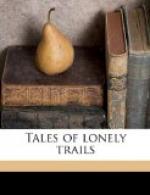This matter of trapping wild animals is singularly hateful to me. Bad enough is it to stalk deer to shoot them for their meat, but at least this is a game where the deer have all the advantage. Bad indeed it may be to chase bear with hounds, but that is a hard, dangerous method of hunting which gives it some semblance of fairness. Most of my bear hunts proved to me that I ran more risks than the bears. To set traps, however, to hide big iron-springed, spike-toothed traps to catch and clutch wild animals alive, and hold them till they died or starved or gnawed off their feet, or until the trapper chose to come with his gun or club to end the miserable business—what indeed shall I call that? Cruel—base—cowardly!
It cannot be defended on moral grounds. But vast moneyed interests are at stake. One of the greatest of American fortunes was built upon the brutal, merciless trapping of wild animals for their furs. And in this fall of 1919 the prices of fox, marten, beaver, raccoon, skunk, lynx, muskrat, mink, otter, were higher by double than they had ever been. Trappers were going to reap a rich harvest. Well, everybody must make a living; but is this trapping business honest, is it manly? To my knowledge trappers are hardened. Market fishermen are hardened, too, but the public eat fish. They do not eat furs. Now in cold climates and seasons furs are valuable to protect people who must battle with winter winds and sleet and ice; and against their use by such I daresay there is no justification for censure. But the vast number of furs go to deck the persons of vain women. I appreciate the beautiful contrast of fair skin against a background of sable fur, or silver fox, or rich, black, velvety seal. But beautiful women would be just as beautiful, just as warmly clothed in wool instead of fur. And infinitely better women! Not long ago I met a young woman in one of New York’s fashionable hotels, and I remarked about the exquisite evening coat of fur she wore. She said she loved furs. She certainly was handsome, and she appeared to be refined, cultured, a girl of high class. And I said it was a pity women did not know or care where furs came from. She seemed surprised. Then I told her about the iron-jawed, spike-toothed traps hidden by the springs or on the runways of game—about the fox or beaver or marten seeking its food, training its young to fare for themselves—about the sudden terrible clutch of the trap, and then the frantic fear, the instinctive fury, the violent struggle—about the foot gnawed off by the beast that was too fierce to die a captive—about the hours of agony, the horrible thirst—the horrible days till death. And I concluded: “All because women are luxurious and vain!” She shuddered underneath the beautiful coat of furs, and seemed insulted.




